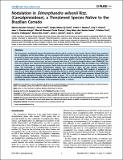Por favor, use este identificador para citar o enlazar a este item:
http://hdl.handle.net/10261/96919COMPARTIR / EXPORTAR:
 SHARE SHARE
 CORE
BASE CORE
BASE
|
|
| Visualizar otros formatos: MARC | Dublin Core | RDF | ORE | MODS | METS | DIDL | DATACITE | |

| Campo DC | Valor | Lengua/Idioma |
|---|---|---|
| dc.contributor.author | Bacelar Fonseca, Márcia | - |
| dc.contributor.author | Peix, Álvaro | - |
| dc.contributor.author | Mateos, Pedro F. | - |
| dc.contributor.author | Rivera, Lina P. | - |
| dc.contributor.author | Velázquez Pérez, Encarna | - |
| dc.contributor.author | James, Euan Kevin | - |
| dc.date.issued | 2012-11-19 | - |
| dc.identifier.citation | PLoS ONE 7(11): e49520 (2012) | es_ES |
| dc.identifier.uri | http://hdl.handle.net/10261/96919 | - |
| dc.description | 16 páginas, 7 figuras. | es_ES |
| dc.description.abstract | The threatened caesalpinioid legume Dimorphandra wilsonii, which is native to the Cerrado biome in Brazil, was examined for its nodulation and N2-fixing ability, and was compared with another, less-threatened species, D. jorgei. Nodulation and potential N2 fixation was shown on seedlings that had been inoculated singly with five bradyrhizobial isolates from mature D. wilsonii nodules. The infection of D. wilsonii by two of these strains (Dw10.1, Dw12.5) was followed in detail using light and transmission electron microscopy, and was compared with that of D. jorgei by Bradyrhizobium strain SEMIA6099. The roots of D. wilsonii were infected via small transient root hairs at 42 d after inoculation (dai), and nodules were sufficiently mature at 63 dai to express nitrogenase protein. Similar infection and nodule developmental processes were observed in D. jorgei. The bacteroids in mature Dimorphandra nodules were enclosed in plant cell wall material containing a homogalacturonan (pectic) epitope that was recognized by the monoclonal antibody JIM5. Analysis of sequences of their rrs (16S rRNA) genes and their ITS regions showed that the five D. wilsonii strains, although related to SEMIA6099, may constitute five undescribed species of genus Bradyrhizobium, whilst their nodD and nifH gene sequences showed that they formed clearly separated branches from other rhizobial strains. This is the first study to describe in full the N2-fixing symbiotic interaction between defined rhizobial strains and legumes in the sub-family Caesalpinioideae. This information will hopefully assist in the conservation of the threatened species D. wilsonii. | es_ES |
| dc.description.sponsorship | This work was partly funded by CAPES grant 2127/09-1 (www.capes.gov.br) and by CSIC grant AGL2008-03360 (www.csic.es), which provided a JAE-predoc scholarship. The funders had no role in study design, data collection and analysis, decision to publish, or preparation of the manuscript. | - |
| dc.language.iso | eng | es_ES |
| dc.publisher | Public Library of Science | es_ES |
| dc.relation.isversionof | Publisher's version | - |
| dc.rights | openAccess | es_ES |
| dc.title | Nodulation in Dimorphandra wilsonii Rizz. (Caesalpinionideae), a threatened Species Native to the Brazilian Cerrado | es_ES |
| dc.type | artículo | es_ES |
| dc.identifier.doi | 10.1371/journal.pone.0049520 | - |
| dc.description.peerreviewed | Peer reviewed | es_ES |
| dc.relation.publisherversion | http://dx.doi.org/10.1371/journal.pone.0049520 | es_ES |
| dc.identifier.e-issn | 1932-6203 | - |
| dc.rights.license | http://creativecommons.org/licenses/by-nc-sa/4.0/ | - |
| dc.identifier.pmid | 23185349 | - |
| dc.type.coar | http://purl.org/coar/resource_type/c_6501 | es_ES |
| item.openairetype | artículo | - |
| item.openairecristype | http://purl.org/coar/resource_type/c_18cf | - |
| item.grantfulltext | open | - |
| item.fulltext | With Fulltext | - |
| item.languageiso639-1 | en | - |
| item.cerifentitytype | Publications | - |
| Aparece en las colecciones: | (IRNASA) Artículos | |
Ficheros en este ítem:
| Fichero | Descripción | Tamaño | Formato | |
|---|---|---|---|---|
| Nodulation in Dimorphandra wilsonii Rizz. (Caesalpinionideae), a threatened Species Native to the Brazilian Cerrado.pdf | 2,25 MB | Adobe PDF |  Visualizar/Abrir |
CORE Recommender
PubMed Central
Citations
7
checked on 22-abr-2024
SCOPUSTM
Citations
33
checked on 19-abr-2024
WEB OF SCIENCETM
Citations
29
checked on 24-feb-2024
Page view(s)
292
checked on 24-abr-2024
Download(s)
224
checked on 24-abr-2024

